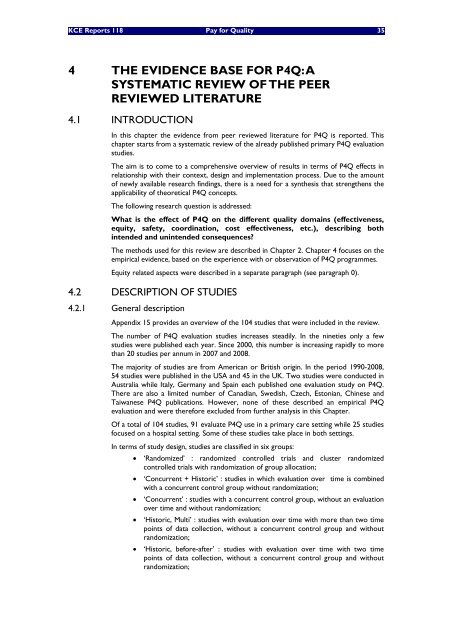Pay for Quality
Pay for Quality
Pay for Quality
Create successful ePaper yourself
Turn your PDF publications into a flip-book with our unique Google optimized e-Paper software.
KCE Reports 118 <strong>Pay</strong> <strong>for</strong> <strong>Quality</strong> 35<br />
4 THE EVIDENCE BASE FOR P4Q: A<br />
SYSTEMATIC REVIEW OF THE PEER<br />
REVIEWED LITERATURE<br />
4.1 INTRODUCTION<br />
In this chapter the evidence from peer reviewed literature <strong>for</strong> P4Q is reported. This<br />
chapter starts from a systematic review of the already published primary P4Q evaluation<br />
studies.<br />
The aim is to come to a comprehensive overview of results in terms of P4Q effects in<br />
relationship with their context, design and implementation process. Due to the amount<br />
of newly available research findings, there is a need <strong>for</strong> a synthesis that strengthens the<br />
applicability of theoretical P4Q concepts.<br />
The following research question is addressed:<br />
What is the effect of P4Q on the different quality domains (effectiveness,<br />
equity, safety, coordination, cost effectiveness, etc.), describing both<br />
intended and unintended consequences?<br />
The methods used <strong>for</strong> this review are described in Chapter 2. Chapter 4 focuses on the<br />
empirical evidence, based on the experience with or observation of P4Q programmes.<br />
Equity related aspects were described in a separate paragraph (see paragraph 0).<br />
4.2 DESCRIPTION OF STUDIES<br />
4.2.1 General description<br />
Appendix 15 provides an overview of the 104 studies that were included in the review.<br />
The number of P4Q evaluation studies increases steadily. In the nineties only a few<br />
studies were published each year. Since 2000, this number is increasing rapidly to more<br />
than 20 studies per annum in 2007 and 2008.<br />
The majority of studies are from American or British origin. In the period 1990-2008,<br />
54 studies were published in the USA and 45 in the UK. Two studies were conducted in<br />
Australia while Italy, Germany and Spain each published one evaluation study on P4Q.<br />
There are also a limited number of Canadian, Swedish, Czech, Estonian, Chinese and<br />
Taiwanese P4Q publications. However, none of these described an empirical P4Q<br />
evaluation and were there<strong>for</strong>e excluded from further analysis in this Chapter.<br />
Of a total of 104 studies, 91 evaluate P4Q use in a primary care setting while 25 studies<br />
focused on a hospital setting. Some of these studies take place in both settings.<br />
In terms of study design, studies are classified in six groups:<br />
• ‘Randomized’ : randomized controlled trials and cluster randomized<br />
controlled trials with randomization of group allocation;<br />
• ‘Concurrent + Historic’ : studies in which evaluation over time is combined<br />
with a concurrent control group without randomization;<br />
• ‘Concurrent’ : studies with a concurrent control group, without an evaluation<br />
over time and without randomization;<br />
• ‘Historic, Multi’ : studies with evaluation over time with more than two time<br />
points of data collection, without a concurrent control group and without<br />
randomization;<br />
• ‘Historic, be<strong>for</strong>e-after’ : studies with evaluation over time with two time<br />
points of data collection, without a concurrent control group and without<br />
randomization;
















